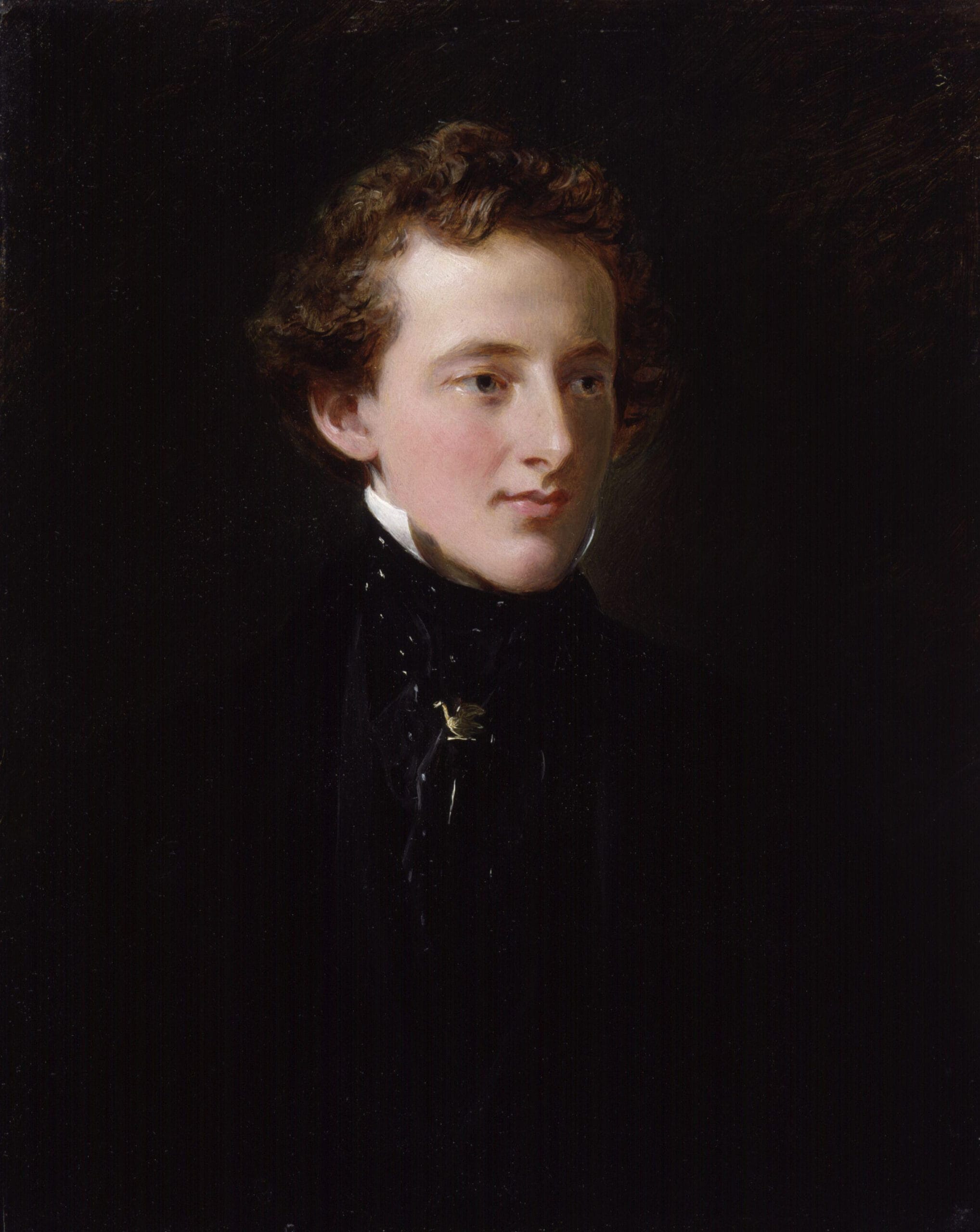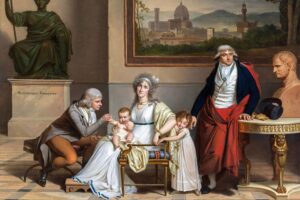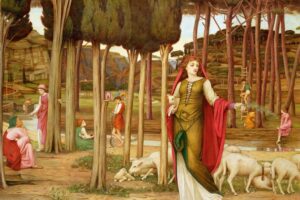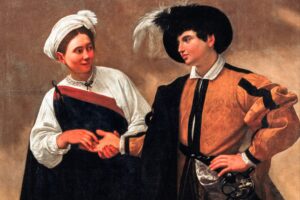Overview
Peace Concluded (1856) by John Everett Millais blends domestic tenderness with public history. Painted at the close of the Crimean War, it shows a wounded officer resting with his wife and children. The newspaper she holds proclaims the end of war, while the family’s unity suggests renewal and healing.
Millais, one of the founding members of the Pre-Raphaelite Brotherhood, here turned from biblical and literary subjects to contemporary life. The result is both symbolic and intimate: a Victorian family portrait that celebrates peace through the language of home, affection, and resilience.
The Story Behind the Painting
The Crimean War and Its End
The Crimean War (1853–1856), fought between Russia and an alliance including Britain, France, and the Ottoman Empire, ended with the Treaty of Paris in 1856. News of the war’s conclusion was greeted with relief across Britain, where families longed for the return of soldiers.
Millais responded by painting this allegory of peace within the home. The father, visibly a soldier wounded in battle, reclines as his wife and daughters surround him, their presence embodying the comfort of love and the promise of normal life restored.
Millais and Domestic Themes
Though best known for works like Ophelia and Christ in the House of His Parents, Millais often turned to contemporary domestic subjects in the 1850s and 1860s. Peace Concluded reveals his ability to merge current events with intimate realism, appealing to Victorian audiences who valued both patriotism and the sanctity of family life.
Exhibition and Reception
When exhibited at the Royal Academy in 1856, the painting was warmly received. Critics praised its sentiment and clarity, noting its mixture of symbolic meaning with the everyday warmth of family life.
Composition and Subjects
The Officer at Rest
At the center sits the officer, his face weary but serene, dressed in dark uniform. He leans against his wife, who gently supports him, embodying both care and strength. His bandaged hand hints at sacrifice, while his relaxed posture suggests relief after hardship.
The Wife with the Newspaper
The officer’s wife, finely dressed in patterned fabrics, holds up a newspaper announcing the end of war. Her gaze is calm yet dignified, her arm draped protectively around her husband. She represents stability, the figure who bridges public history and private joy.
The Children at Play
In the foreground, two daughters enliven the scene. One, dressed in blue and white, plays with toy animals — including a lion and a lamb — clear symbols of peace. The other, more solemn, gazes outward as if connecting the family’s joy with the viewer. A box of toy soldiers lies at her side, suggesting that conflict, too, has been put aside.
The Family Dog
At the right, a loyal dog rests quietly, symbolizing fidelity and domestic harmony. His presence reinforces the sense of trust, safety, and wholeness restored.
Symbolic Layering
The painting carefully balances allegory with naturalism. The lion and lamb toys echo biblical imagery of peace, the newspaper links the scene to current events, and the family grouping conveys Victorian ideals of love, duty, and stability.
Art Style and Techniques
Pre-Raphaelite Precision
Though more restrained than Millais’s early religious works, Peace Concluded still reflects Pre-Raphaelite ideals. Fabrics, hair, and objects are painted with minute detail, and the bright palette ensures clarity across the canvas.
Realism and Sentiment
Millais renders the figures with warmth and immediacy, capturing tenderness in gesture and expression. At the same time, the painting’s symbolism ensures that it is more than portraiture — it is narrative, carrying moral and patriotic weight.
Balance of Public and Private
The painting blends public history — the Crimean War’s end — with private life, showing how national events reverberate in the home. This duality gave the work broad appeal to Victorian viewers.
Legacy and Reflection
A Victorian Favorite
Peace Concluded remains one of Millais’s most celebrated domestic works. It demonstrates his range, showing how the Pre-Raphaelite painter of myth and tragedy could also turn his skill to everyday life, investing it with depth and meaning.
Enduring Relevance
The painting still speaks across centuries as an image of healing after conflict. Its message is simple yet powerful: peace is not only treaties and politics but also the embrace of family, the laughter of children, and the quiet presence of love.
He rests against his wife, children playing at his side, while the news of peace lies open in her hand. In this intimate moment, Millais captures more than one family’s relief — he paints the universal longing for war to end, and for love to begin again.
About Artist

Sir John Everett Millais, 1st Baronet PRA (June 8, 1829 – August 13, 1896), was an English painter and illustrator, famously one of the founders of the Pre-Raphaelite Brotherhood. Born in Southampton, Millais showed early artistic talent and was the youngest student admitted to the Royal Academy Schools at age eleven. The Pre-Raphaelite Brotherhood, founded at his family home in London, challenged the prevailing artistic conventions by emphasizing naturalism, vivid detail, and complex symbolism. Millais became the most famous exponent of the style, though his later work evolved toward a more mainstream Victorian realism.
Artist Style and Movement
Millais’s early work epitomizes the Pre-Raphaelite style, notable for its vibrant colors, painstaking detail, and historical or literary subjects often laden with symbolism and emotional intensity. His early paintings often stirred controversy for their realism applied to sacred or historical themes. Later in life, Millais shifted towards a broader realism, which garnered him vast success and official acclaim, including presidency of the Royal Academy. Despite criticism from some contemporaries for this stylistic shift, his work remains crucial in understanding Victorian art.
Notable Works
- Mariana (1851), an iconic Pre-Raphaelite image of yearning and waiting, inspired by Tennyson’s poem.
- Isabella (1848–1849), a vivid narrative painting illustrating a tragic Renaissance tale in exquisite detail.
- Christ in the House of His Parents (1849-1850), a controversial yet seminal work depicting a realistic Holy Family at work.
- A Dream of the Past Sir Isumbras at the Ford (1857), a dramatic medieval scene emphasizing chivalry and heroism.
- Peace Concluded (1856), a romantic allegory celebrating harmony.
- Love and the Maiden (1877), an allegorical work showcasing Millais’s mature style.
- Charon and Psyche (1883), inspired by classical mythology and exploring themes of soul and death.
- Pine Woods at Viareggio (1888), a landscape reflecting his Italian influences.
- The Gentle Music of a Bygone Day (1873), evoking nostalgia and memory through genre scenes.
- The Waters of Lethe by the Plains of Elysium (1880), a symbolic painting referencing classical mythology.
- The North-West Passage (1874), a patriotic and historical narrative celebrated in British art.
- An Idyll of 1745 (1884), depicting a romanticized historical rural scene.
John Everett Millais’s career was a defining force in Victorian art, shaping the Pre-Raphaelite movement and influencing generations of British painters. His ability to combine technical virtuosity with deep narrative and emotional resonance made him both commercially successful and artistically influential. Alongside his dramatic early works, his later mastery of portraiture and landscape confirmed his status as one of the foremost artists of 19th-century Britain.
This Painting, Peace Concluded, is Featured in (Pre-Raphaelite Spot the Difference Puzzles: Interactive, Printable Flipbook) by Classic Art Puzzles.



